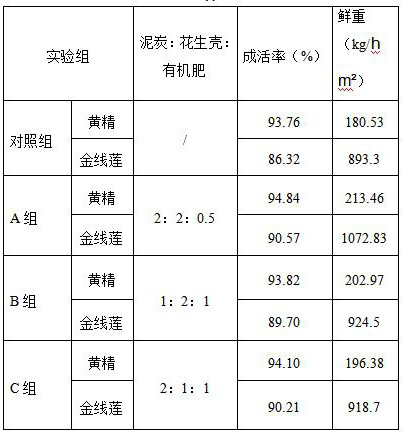Interplanting method of anoectochilus roxburghii and polygonatum sibiricum under forests
A technology of interplanting under forest and Polygonatum chinensis, which is applied in the fields of botanical equipment and methods, land preparation methods, gardening methods, etc., can solve the problems of low plant survival rate, etc., so as to improve the survival rate, reduce costs, and alleviate soft rot and stem rot. effect of disease
- Summary
- Abstract
- Description
- Claims
- Application Information
AI Technical Summary
Problems solved by technology
Method used
Image
Examples
Embodiment 1
[0022] Embodiment 1, the impact of different disinfecting multiple solutions on the survival rate of Clematis clematis and Rhizoma Polygonatum
[0023]Set up an experimental group, choose moso bamboo forest, chestnut forest or fir forest with no serious pests and diseases and light transmittance of 40-50%; choose plots with an altitude of ≤800 m and a slope of ≤ 25°, with loose, fertile and moist soil, The proportion of humus soil is high, and the soil pH of the plot is 4.5-7.0; the weeds, shrubs and vines on the plot should be cleaned first, and then the plot should be plowed. For multiple planting belts of m~1.2 m, there is a gap between two adjacent planting belts to form an ecological protection belt with a width of 0.5 m~0.7 m. For the original horizontal belt, keep 30 cm~50 cm outside the horizontal belt , no soil preparation, deep plowing in the middle of the horizontal zone by 20 cm~30 cm, and a drainage ditch with a width of 20 cm~30 cm on the inner side of the horizo...
Embodiment 2
[0029] Embodiment 2, the impact of different cultivation substrates on the survival rate of Aureus clematis and sealwort
[0030] Set up an experimental group, choose moso bamboo forest, chestnut forest or fir forest with no serious pests and diseases and light transmittance of 40-50%; choose plots with an altitude of ≤800 m and a slope of ≤ 25°, with loose, fertile and moist soil, The proportion of humus soil is high, and the soil pH of the plot is 4.5-7.0; the weeds, shrubs and vines on the plot should be cleaned first, and then the plot should be plowed. For multiple planting belts of m~1.2 m, there is a gap between two adjacent planting belts to form an ecological protection belt with a width of 0.5 m~0.7 m. For the original horizontal belt, keep 30 cm~50 cm outside the horizontal belt , no soil preparation, deep plowing in the middle of the horizontal zone by 20 cm~30 cm, and a drainage ditch with a width of 20 cm~30 cm on the inner side of the horizontal zone; apply 1300...
PUM
 Login to View More
Login to View More Abstract
Description
Claims
Application Information
 Login to View More
Login to View More - R&D
- Intellectual Property
- Life Sciences
- Materials
- Tech Scout
- Unparalleled Data Quality
- Higher Quality Content
- 60% Fewer Hallucinations
Browse by: Latest US Patents, China's latest patents, Technical Efficacy Thesaurus, Application Domain, Technology Topic, Popular Technical Reports.
© 2025 PatSnap. All rights reserved.Legal|Privacy policy|Modern Slavery Act Transparency Statement|Sitemap|About US| Contact US: help@patsnap.com


